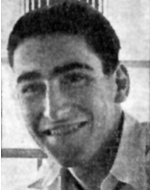Feilchenfeld, Michael (Kurt)
Son of Liselotte and Dr. Rudolf, was born on January 19, 1929, in Berlin, the capital of Germany. When he was six, he was admitted to an urban school. Unable to bear the bad treatment of German children, he was transferred to a Jewish school. He was very interested in the knowledge of Judaism given in the framework of “religious studies,” and at the age of eight he joined the Bar Kokhba youth movement. When he was nine years old, in September 1938, the family immigrated to Israel, where he studied at the “son of Yehuda” Gymnasium, moved to the Shalva Gymnasium, finished sixth grade and passed the London matriculation exams, He studied books about the greatest medical doctors in the world, and chose his future career in this field: After the matriculation exams he worked as a store clerk, took his job seriously and liked the business owner, and learned Latin and French in the evenings that he was supposed to be accepted as a medical student at the University of Geneva in the fall. He moved with a group of members of the Habonim youth movement and was one of its founders, and when he was 15, he joined the Haganah He had taken on difficult roles and was exemplary in growing his willpower over fatigue and slackness because of the tension in the country ahead of the UN decision in the autumn of 1947, he refused to start his studies in Switzerland and in his letters to relatives abroad. When the decision was made at Lake Success, the seat of the United Nations General Assembly, which decided to divide the country into two states, the war broke out, and he joined the service of the Haganah in Tel Aviv. When one of his parents’ acquaintances was killed on the way to Jerusalem, he comforted them with a gloomy vision: “There will be more victims in the community.” A week later, he was also one of these victims. On December 14, 1947, a caravan of seven cars with 48 fighters emerged from Petach Tikvah as reinforcements for a fat white boy, to surprise the convoy, not through the regular route, but through Migdal Tzedek and Beit-Nabala. After arriving at the army camps in Beit Nabala, heavy fire was fired upon by a unit of the Arab Legion that was in the area, and was brought to rest at the Nachlat Yitzhak military cemetery. A special page appeared in the booklet “How Heroes Fell” in memory of the 11 victims of the convoy to son of Shemen.
